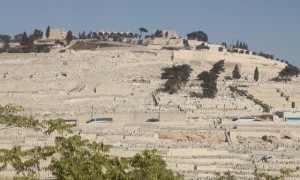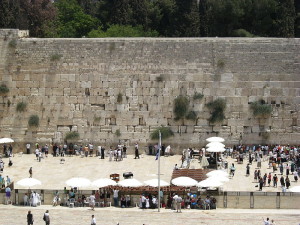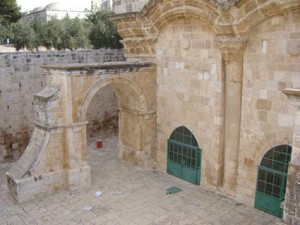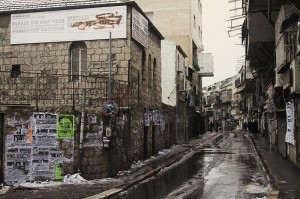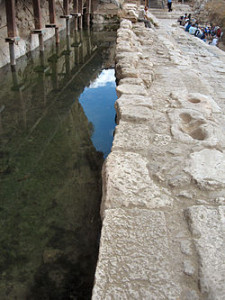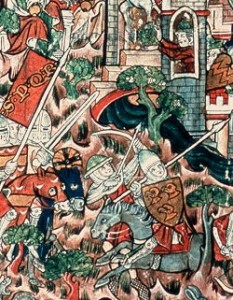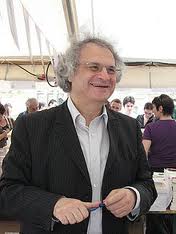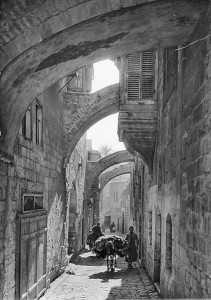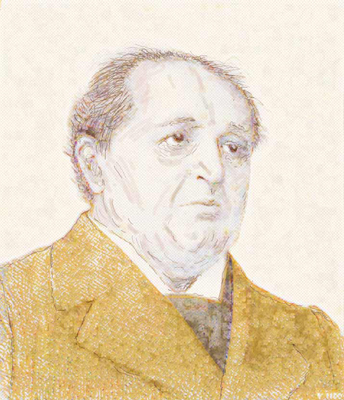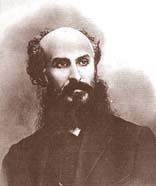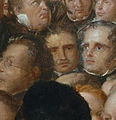God wil het! – XIV – Reizen in het spoor van de kruisvaarder
Jeruzalem: God wil het!
‘Jeruzalem sla uw ogen op en zie de bevrijder,
die uw boeien komt verbreken’ (Jesaja)
Vanuit de richting van Bethlehem trok het kruisleger door de heuvels van Judea naar Jeruzalem. Vanaf de Olijfberg keken ze neer op de muren en de heiligdommen van de oude stad, die net als in onze tijd verdeeld was in vier wijken: voor moslims, joden, Armeense christenen en Latijnse en orthodoxe christenen. De ongeveer vijfduizend christenen wonen tegenwoordig in de nabije omgeving van de Heilige-Grafkerk, de plaats waar Jezus zou zijn begraven na zijn kruisiging. Hier bevinden zich ook hun kerken, kloosters en pelgrimshuizen. De Franciscanen zijn de belangrijkste vertegenwoordigers van de Latijnse christenen en regelen hun zaken vanuit hun hoofdkwartier in het klooster van de Heilige Verlosser in de omgeving van de Jaffa poort. Met de Latijnen zijn de Grieks-Orthodoxen de meest dominant aanwezige christenen in het straatbeeld en in de wijk rond de Nieuwe poort bewoont hun kerkelijke elite de fraaiste huizen van de oude stad. Kleinere gemeenschappen zoals de Kopten, de Protestanten en de Ethiopiërs leven meer teruggetrokken in gebouwen die soms nog dateren uit de tijd van het vroegste christendom. De Ethiopische monniken wonen tussen de ruïnes van een door de kruisvaarders gebouwd klooster dat tegen de Heilige Grafkerk is aangebouwd. De Armenen namen aan het begin van de vierde eeuw als eersten het christendom aan en bewonen een van de grootste en ruimst opgezette wijken van de oude stad.
Na de massamoorden door de Turken in 1915 werd het een belangrijk toevluchtsoord voor de overlevende Armenen. Door voortdurende emigratie naar Amerika en West-Europa is het aantal christelijke Armeniërs in deze mini-stad met haar grote pleinen, scholen, bibliotheken en woonhuizen teruggelopen tot een kleine duizend. In het zuidoostelijk deel van Jeruzalem bevindt zich de joodse wijk met de belangrijke westelijke muur, ook wel de Klaagmuur genoemd. Nadat Oud-Jeruzalem in 1948 door de Jordaniërs werd ingenomen, vertrokken de oorspronkelijke bewoners naar het moderne West-Jeruzalem. De Klaagmuur kon alleen met toestemming van de bezetter worden bezocht. 1967 kwam de stad weer in Israëlische handen en werd in het joodse gedeelte onmiddellijk begonnen met de aanleg van nieuwe woonwijken bestaande uit moderne, witte terrasgewijze gebouwde huizen. Toch bleven de joden hier een kleine minderheid en ook de joodse bewoners van het nieuwe West-Jeruzalem leggen niet vaak een bezoek af aan de oude stad.
Veruit het grootste deel van de bevolking van Oud-Jeruzalem bestaat uit moslims en dan voornamelijk Palestijnen. In hun woonwijk in het noordoostelijk stadsdeel bevinden zich nog her en der verspreid historische gebouwen uit de vroegchristelijke en kruisvaarders periode. De door christelijke pelgrims druk bezochte Via Dolorosa kronkelt dwars door hun woongebied en de smalle, donkere met zonwerende doeken overspannen straatjes van de Arabische markt met haar kleurrijke en geurige winkeltjes. Het is de enige plaats in Jeruzalem waar nog een echte oosterse sfeer hangt.
Het volgend jaar in Jeruzalem
Buiten de muren van de oude stad, in het stadsdeel voor de Damascuspoort, wonen joden en Palestijnen naast elkaar. Het is een soort overgangsgebied met het uitsluitend door joden bewoonde nieuwe West-Jeruzalem, dat zich na de stichting van de staat Israël en de komst van honderdduizenden emigranten in alle richtingen uitbreidde. Een grote snelweg richting Bethlehem dient onder meer als uitvalsweg voor de nieuwe zuidelijke stadsdelen waar de ene na de andere wijk met voornamelijk luxe woningen uit de grond wordt gestampt. Ze staan in schril contrast met de slechts een paar honderd meter verderop gelegen armoedige Palestijnse nederzettingen in de vlakte van Silwan, maar in Jeruzalem liggen sociale-, culturele- en religieuze ontwikkelingen letterlijk en figuurlijk naast en over elkaar heen gestapeld.
Zo werd op het Tempelplein de Rotskoepel, vanwaar Mohammed op een wit gevleugeld paard ten hemel steeg, over de ruïnes van de tempel van Salomo heen gebouwd. Aan de andere kant van de westelijke muur van het Tempelplein beklagen de joden nog dagelijks het verlies van hun tempel en het noodlot dat hen dwong bijna tweeduizend jaar in de diaspora tussen de ongelovigen te leven. De begroeting ‘Het volgend jaar in Jeruzalem’, waarmee de verbannen joden het verlangen naar de verloren stad uitdrukten, wordt niet meer gehoord, maar de geschiedenis laat zich niet wegdrukken. Vreedzaam samenleven was in het verleden niet altijd mogelijk en het straatbeeld nu, met vele zwaar bewapende in legergroen geklede jongens en meisjes, toont dat de nieuwe heerser zich heeft voorgenomen zijn terugveroverde heiligdommen zo duur mogelijk te verkopen.
Buiten de westelijke muur, in de vallei van Kidron en aan de voet van de Olijfberg ligt ’s werelds grootste en oudste joodse begraafplaats. Het is een voorrecht hier begraven te worden, want dit is de plaats van de wederopstanding waar de doden op de dag des oordeels als eersten door God in hun graven worden gewekt en onder leiding van de Messias door de twee ingangen van de Gouden poort de oude stad binnentreden. Maar deze poort geeft toegang tot het voor moslims heilige Tempelplein. Voor de zekerheid hebben ze daarom de poort in de zevende eeuw dichtgemetseld, en – wetende dat joodse geestelijken en dus ook de Messias – geen dodenakker mogen betreden – aan de voet van de muur voor de ingang van de poort een islamitische begraafplaats aangelegd. Religieuze gevoeligheden, die door de eeuwen heen tot de dag van vandaag vaak in kinderachtig getreiter ontaardden. Vanaf de Gouden poort zijn in de vallei de graven van Absalom en Zacharias duidelijk zichtbaar. Een man uit het nabijgelegen Palestijnse stadje Silwan onderneemt een lange klimtocht om zijn diensten als gids aan te bieden. Er zijn bijna net zoveel net zoveel Palestijnse gidsen als toeristen. De werkloosheid onder de Palestijnen is enorm hoog en om een paar centen te verdienen zijn deze gidsen – met bloedend hart – bereid enthousiast uitleg te geven over de joodse en christelijke heiligdommen. Ibrahim is zo’n gids. Hij wijst naar de gigantische joodse begraafplaats, waar een groep orthodoxe joden ‘knipmessend’ staat te bidden bij een graf: lange baarden, pijpenkrullen (peies) langs de slapen, een paar maten te kleine zwarte hoeden of grote bontmutsen (shtreimels) op het hoofd en gekleed in lange, zwarte kaftans en kousen. ‘Daar ligt een belangrijke rabbijn,’ zegt Ibrahim en vervolgt op smalende toon: ‘Ze stoppen briefjes in het graf en denken dat hij hun wensen verhoord. Dat helpt natuurlijk niet, want de man is dood.’ ‘En Mohammed dan?, die is ook dood en hoort en ziet toch ook alles?’. Er komt geen antwoord. Dit Jeruzalem, waarin de politieke en religieuze omstandigheden de mensen in hoge mate hebben gefrustreerd, is niet de plaats voor relativerende gesprekken.
Een staat binnen de staat
Vanaf de begraafplaats keren de joden terug naar hun eigen wijk, Mea She’arim. Het is een enclave in het centrum van de nieuwe stad, die zich laat vergelijken met een vooroorlogse Oost-Europese sjtetl: een stadsdeel vol traditionele Asjkenazische en ultra-orthodoxe Chassidische joden die alleen het koninkrijk Gods erkennen en daarom de staat Israël afwijzen. Er heerst een sfeer van eeuwen geleden. Vrouwen en meisjes met enkellange rokken, lange mouwen en het haar boven de bleke gezichten afgedekt met pruiken en hoedjes, schuifelen met krakkemikkige kinderwagens langs de huizen. De kleine straatjes zijn gevuld met Judaïcawinkeltjes, streng kosjere eethuisjes, tientallen synagogen en thora-scholen. Een groepje ongeveer twaalf jaar oude jongetjes wacht onder toezicht van de vaders hun beurt af bij een kapper, die volgens het voorgeschreven regime voorzichtig met zijn schaar om de lange haarlokken heen manoeuvreert. Aan de straatmuren hangen pamfletten waarop de bewoners de – buitenlandse – bezoekers oproepen zich decent te kleden en de Thora (de vijf boeken van Mozes) en de lokale vrouwen en meisjes te eerbiedigen.
Even verderop, in het wat vrijere uitgaanscentrum rond Yehudastraat swingt de stad een beetje met haar gezellige terrassen, straatmuziek en flanerende uitdagende tieners. Het is vrijdagavond om een uur of zeven en de zon neigt naar de kim. Plotseling worden de terrassen afgebroken. Winkeliers vergrendelen de deuren en ramen. Bussen houden op met rijden. Binnen enkele minuten zijn de straten leeg. Met snelle pas spoeden enkele in het zwart geklede mannen zich richting synagoge. In de anders zo levendige Jaffastraat hangt een sinistere sfeer. Een felle wind steekt op en waait een wolk van stofzand omhoog. De macht van Het Woord laat zich gelden: het is Sabbat.
Het laatste hoofdstuk
‘Toen zijn de laatste berg beklommen hadden, vertoonde zich Jeruzalem plotseling aan hun ogen. De eersten die de stad zagen riepen in vervoering uit: “Jeruzalem! Jeruzalem!” De naam vliegt van mond tot mond, van gelid tot gelid en weergalmt in de dalen, waar zich nog de achterhoede der kruisvaarders bevond. “O goed Jezus,” zegt de monnik Robertus, die ooggetuige was, “welk een vloed van tranen welde op uit de ogen der christenen, toen zij uwe heilige stad aanschouwden.”’
Het allerheiligste was bereikt. Het doel van de reis waarvoor de tienduizenden drie lange jaren hadden geleden en gebeden lag beneden in het dal te wachten op de redders van het enige ware geloof. Alleen de muren stonden nog in de weg van het leger dat op het punt stond de geschiedenis te veranderen. Maar om hoeveel strijders en verdedigers ging het helemaal? Als we de realistische schattingen van Sir Steven Runciman, onze leidsman in de kruisvaartgeschiedenis, blijven volgen dan vertrok het kruisleger op volle sterkte met zo’n 3500 geharnaste ridders en 30.000 man voetvolk uit Constantinopel en kwamen hiervan niet meer dan 1300 ridders en 12.000 infanteristen in Jeruzalem aan. Het merendeel van de niet strijdende achterhoede was onderweg door geweld, honger en ellende omgekomen of had zich ergens langs de route als emigrant tussen de autochtone christelijke bevolking gevestigd. Het waren bijna uitsluitend nog getrainde strijders die de stad, waar naar schatting slechts enkele duizenden mensen woonden, belegerden.
Door de lengte en de ligging van de muren op geaccidenteerd terrein was het onmogelijk voor de kruisvaarders om de hele stad te omsingelen. Daarom concentreerden de in groepen opgesplitste manschappen zich op plaatsen waar de muur het gemakkelijkst bereikt kon worden. Godfried sloeg zijn kampement op voor de huidige Jaffapoort, waar twee standbeelden herinneringen oproepen aan de gebeurtenissen. Een kruisridder met schild en banier staat met zijn merrie neus aan neus met de volbloedhengst van zijn zwaar bewapende islamitische tegenstander. Staan hier Godfried en de Fatimiden stadsbestuurder Iftikhar tegenover elkaar? Waarschijnlijk zijn het twee anonieme strijders, want noch Godfried, noch van zijn opponent is het uiterlijk bekend. Iftikhar ad-Dawla had de christenen, die in Jeruzalem een meerderheid vormden, gedwongen om de stad te verlaten. Daarmee raakte hij een potentiële vijand binnen de muren kwijt en kon hij de voedselproblemen beter het hoofd bieden.
Alleen de joodse gemeenschap kon blijven. De joden woonden destijds in het noordelijk deel van de stad vlak achter de plaats waar Godfried uiteindelijk de muur bestormde, waardoor mag worden aangenomen dat ze hebben deelgenomen aan de zwaarste gevechten. ‘De komst van de eerste kruistocht betekende een keerpunt in de geschiedenis van de joden in dit land,’ zegt de Israëlische kruisvaartdeskundige Benjamin Kedar, hoogleraar aan de Hebreeuwse Universiteit. ‘Voor de kruisvaarders,’ vervolgt Kedar, ‘was hier een stevig gewortelde joodse gemeenschap met eigen instituties en een behoorlijke invloed op het economische en intellectuele leven. Met de komst van de Fatimiden ging de positie van de joden geleidelijk achteruit, alhoewel er tijdens het moslim bestuur geen sprake is geweest van ernstige vervolgingen. Net al de christenen konden ze hun geloof in vrijheid belijden, maar ze waren geen volwaardige burgers en moesten belasting betalen voor de bescherming die ze ontvingen.’
Na het verdrijven van de christenen liet Iftikhar de kudden wegvoeren en de bronnen rond de stad vergiftigen, waardoor de op enkele kilometers van de stad gelegen historische poel van Siloam de enige watervoorziening werd. Maar deze plaats was kwetsbaar voor beschietingen vanuit de stad. ‘Tijdens de belegering werden we zo gekweld door dorst, dat we de huiden van ossen en buffels aan elkaar naaiden, waarmee we over een afstand van tien kilometer water droegen. Vanwege dit smerig ruikende water en het gerstebrood hadden we dagelijks problemen. De muzelmannen lagen in de buurt van de bronnen en overvielen en doodden onze mannen, waarna ze ze in stukken sneden.’ Met de dagelijkse problemen wordt de diarree bedoeld, waar iedereen in die tijd aan leed. Dat ze hier nog eens apart vermeld wordt, duidt er op dat de problemen zelfs naar de onhygiënische maatstaven van de middeleeuwen ernstiger waren dan normaal.
Voor de bouw van de aanvalstorens was er groot gebrek aan bouwmateriaal en met name hout. Tijdens een inspectietocht naar verborgen plaatsen, waar eventueel hout kon worden was ridder Tancred nauwelijks in staat om op zijn paard zitten vanwege een ernstige buikloop. Keer op keer steeg hij af om – wanneer de problemen weer toesloegen – een schuilplaats te zoeken. ‘Door van zijn paard te klimmen hoopte hij de aandacht van de anderen af te leiden, maar toen dit niet zo bleek te zijn trok hij zich steeds verder terug tot hij een holle rots ontdekte en tussen de bomen en de struiken even rust vond. (-) Terwijl Tancred zijn behoefte deed ontdekte hij in een grot er tegenover 400 grote stukken hout. Hij kon zijn ogen niet geloven en zijn vreugde was zo groot dat hij opsprong en met kloppend hart riep: ”Hier makkers! Kom vlug hier! Kijk, God heeft ons meer gegeven dan we zochten.”’
In de haven van Haifa waren Engelse schepen en Genuaanse galeien aangeland met wapens, touw en spijkers, waarmee de oorlogsmachines in elkaar konden worden gezet. De aanvalstorens moesten tot boven aan de meer dan tien meter hoge muur reiken. Daarnaast werd gebruik gemaakt van katapulten en mangonellen, enorme lepels die grote zware stenen over de stadsmuur naar binnen wierpen. De verdedigers op hun beurt probeerden voortdurend de belegeringswerkzaamheden te hinderen. Ze belaagden de aanvallers met pijlen, stenen en allerlei brandende voorwerpen, waarvan het vloeibare vuur in de vorm van kokende pek nog het meest werd gevreesd. Met natte huiden en afdakjes probeerden de kruisvaarders het vege lijf te redden.
Ondanks het verzet uit de stad en voortdurende onderlinge twisten verliepen de voorbereidingen voorspoedig. Van harmonieuze samenwerking was absoluut geen sprake en nog voordat ze de stad in handen hadden was er voortdurend sprake van gekift over de toekomstige status van de stad en de verdeling van de te verwachten buit. Zo had Tancred in Bethlehem tot grote woede van de geestelijken en rivaliserende ridders zijn vaandel geplaatst op de geboortekerk van Christus. Een dergelijke heilige plaats kan niet aan één man toebehoren, was de eensluidende mening en mokkend had de ridder zijn banier weer gestreken. Naar aanleiding van dit incident deelde de meerderheid van de kruisvaarders de opvatting van de geestelijkheid dat er na de verovering van de stad geen sprake kon zijn van een koning van Jeruzalem. Alleen Christus kon koning zijn over de heiligste der heilige steden. Ook werden er al afspraken gemaakt over de verdeling van de buit na de verovering van de stad en een van de regels was, dat wie als eerste een huis betrad, dit als zijn eigendom mocht beschouwen. Om een eind te maken aan al dit onderlinge gekrakeel, dat de vijand alleen maar in de kaart speelde, kwam een priester met de mededeling dat de in Antiochië overleden Bisschop Adhémar aan hem was verschenen. Hij had opdracht gegeven om de onderlinge ruzies te beëindigen en in processie blootsvoets rond de stad te gaan. Als dit met voldoende geloof zou gebeuren, dan zou de stad binnen negen dagen vallen.
De verovering
De bovenzijde van de muur is voor toeristische wandelingen rond de oude stad opengesteld. Aan de kant van de oude stad kijkt ze uit op de vele meters lager gelegen krioelende bazar en de achtertuintjes van Palestijnse families. Aan de andere kant bevindt zich het chaotische verkeer rond het Arabische busstation bij de drukke ingang van de Damascuspoort, waar drommen toeristen na het passeren van allerlei kleine sjacheraartjes de oude stad induiken. Op dezelfde manier waarop de Palestijnen tegenwoordig met enige minachting naar het christelijke gedoe van de toeristen rond de heilige plaatsen in de oude stad kijken, scholden de moslims op vrijdag 8 juli 1099 vanaf de muren naar de zonderlinge processie, die blootsvoets en voorafgegaan door priesters en bisschoppen met relikwieën en kruisen langs de muren trok. Na de rondgang werd de Olijfberg beklommen, waar de onvermoeibare Peter de Hermiet zijn toespraak tot de menigte eindigde met de woorden: ‘Gij ziet het erfdeel van Jezus Christus vertreden door de goddelozen. Ziet daar eindelijk het waardig loon van al uw inspanning. Ziet daar de plaatsen waar God al uw zonden vergeeft en al uw overwinningen zegenen zal.’
Na deze woorden werden de veten even begraven en de handen enthousiast ineengeslagen voor de laatste grote krachtinspanning. Godfried verplaatste zijn troepen gedurende de nacht van de Jaffapoort naar de Heroduspoort, waar een koperen muurplaat in drie talen aan de belangrijke gebeurtenissen herinnert: Op deze plaats brak het kruisvaarders leger onder leiding van Godfried van Bouillon op 15 juli 1099 door de muren. Aan de voet van de muur ligt een plantsoen en net als in de tijd van Godfried bevond zich vlak voor de muur een sloot, die de kruisvaarders met man en macht onder een voortdurend bombardement van stenen en vuur met hout en aarde moesten dempen om de aanvalstorens tot voor de muur te kunnen rollen. Pas vele uren later zagen ze in de middag kans om vanaf de houten toren van Godfried een loopbrug te slaan tot boven op de muur. Twee Vlaamse ridders, Lethold en Engelbert van Doornik genoten de eer om met Godfried van Bouillon en zijn broer Eustachius in hun kielzog als eersten het puik van het Lotharingse leger over de muur te leiden. ‘Te midden van de strijd verschenen twee tovenaressen op de wallen van de stad om de elementen en de machten van de hel te bezweren. Zij vonden de dood, die ze over de christenen afriepen en bezweken onder een hagelbui van pijlen en stenen. Twee Egyptische boodschappers, die gekomen waren om de belegerden aan te sporen omdat er hulp voor hen opdaagde, werden door de kruisvaarders verrast, terwijl ze binnen de stad trachten te geraken. Een hunner werd terstond gedood en na het geheim van zijn zending te hebben geopenbaard werd de ander met behulp van een werktuig tussen de strijdende muzelmannen op de wallen geslingerd.’
Toen de bescherming van de muur wegviel, wisten de moslims dat alles verloren was en een overweldigende meerderheid op het punt stond de stad binnen te dringen. In paniek vluchtten ze naar het tempelgebied, achtervolgd door de kruisvaarders, die als wilden tekeer gingen. Het was een culminatie van drie jaar strijden en lijden en er zijn de meest vreselijke dingen gebeurd. Iedereen die ze op hun weg tegenkwamen werd over de kling gejaagd en de laatste moslims die het overleefd hadden, vluchtten de El-Aqsa moskee binnen of klommen op het dak. Het mocht niet baten. Onder leiding van Tancred ontheiligden de christenen de moskee en werd iedereen ter plaatse vermoord. De joden werden in de hoofd-synagoge gedreven, die daarna in brand werd gestoken. Mannen, vrouwen, kinderen, iedereen die de moordpartij in de kleine straatjes had overleefd, werd hier leven verbrand…
‘Het was zo’n slachtpartij, dat we tot onze enkels in het bloed stonden. Toen alle heidenen waren verslagen, pakten onze mannen een groot aantal mannen en vrouwen in de tempel (Al-Aqsa); ze doodden wie ze wilden en lieten naar keuze anderen leven. Spoedig had ons leger de hele stad ingenomen en goud, zilver, paarden, ezels en huizen met allerlei rijkdommen in bezit genomen. Daarna verzamelden onze manschappen zich om schreeuwend en wenend van vreugde te gaan bidden in de Kerk van het Heilige Graf. De volgende ochtend klommen onze mannen onbevreesd op het dak van de tempel en vielen de overgebleven mannen en vrouwen aan en onthoofdden ze met het blanke zwaard. (-) Daarna kregen we opdracht om alle dode muzelmannen de stad uit te brengen vanwege de vreselijke stank, want de hele stad lag vol met hun lichamen. De Turken die nog leefden moesten de doden tot voor de poorten slepen en maakten er stapels van zo hoog als huizen. Zo’n slachtpartij van heidenen had nog nooit iemand gezien of van gehoord. De stapels lijken waren gelijk pyramiden.’
Stad zonder joden
De massamoord in Jeruzalem schokte de wereld. De stad was op slag beroofd van al haar moslims en joden. ‘Na de inname van Jeruzalem door de kruisvaarders was er in de stad geen jood meer te vinden,’ zegt Benjamin Kedar. ‘Om het met een moderne term te zeggen: Jeruzalem was judenrein.’
Ook vele christenen waren diep geschokt toen de berichten in het Westen doordrongen en de komst van de kruisvaarders heeft de verhoudingen tussen de verschillende religieuze groeperingen in het Midden-Oosten eeuwenlang beïnvloed. In het begin hadden de moslims de Franken als een politieke factor beschouwd. Invallen van vreemde legers waren aan de orde van de dag en steden en landstreken waren er aan gewend geraakt regelmatig van machthebber te wisselen, maar het bloeddorstige fanatisme waarmee de christenen tegen de moslims tekeer gingen, deed het besef ontstaan dat deze indringers veel verder gingen en een Heilige Oorlog voerden die het wezen van de islamitische identiteit bedreigde.
Jihad
‘Jeruzalem is de derde heilige plaats van de islam,’ zegt Kamel Abdel Fattah, die voormalig adviseur is van de – inmiddels overleden – PLO leider Yasser Arafat. Fattah is als historicus verbonden aan de Palestijnse Bir Zeit Universiteit in Ramallah op de Westbank. ‘De val van Jeruzalem werd beweend door iedere moslim. Er ontstond zelf een speciale literatuur, die bestond uit verzen en geschriften waarin de gebeurtenissen in Jeruzalem werden beschreven en waarin de tendens om te treuren in de loop der jaren omsloeg in een roep om wraak, een jihad tegen de kruisvaarders. (* Het principe van de jihad werd al door Mohammed beschreven tijdens de eerste jaren van de islam. Niet in de eerste plaats om andersdenkenden te bestrijden, maar als middel om de islam te verdedigen tegen de ongelovigen.)
Na het bloedbad in Jeruzalem en de stichting van het Koninkrijk Jeruzalem duurde het nog enkele tientallen jaren voordat er sprake was van georganiseerd verzet tegen de kruisvaarders. De Koerdische leider Zengi, heerser van Mosul (in het tegenwoordige Noord-Irak), riep een Heilige Oorlog uit tegen de kruisvaarders en maakte zich als een der eerste moedjahediens onsterfelijk in de islamitische wereld door het graafschap Edessa van de christenen terug te veroveren. Maar er zouden nog vele jaren overheen gaan, voordat Saladin zijn jihad voerde waardoor de kruisvaarders in 1187 uit Jeruzalem werden verdreven en hun macht in het Midden-Oosten verloren. Hierna volgde een periode van meer dan zeven eeuwen Turks bestuur onder de Mamelukken en de Ottomanen, waarin de invloed van de christenen in het Midden-Oosten steeds verder terugliep. Er ontstond een soort status quo, die – met de beperkingen die de joden en christenen opgelegd kregen – een redelijke vorm van samenleven inhield tussen de verschillende geloofsgroepen. Pas toen de ‘Frank’ Napoleon tijdens zijn Egyptische campagne doordrong in het Midden-Oosten en in 1799 een bloedbad aanrichtte in de stad Jaffa werd de herinnering aan de feranga’s (zoals de vreemden uit het Westen sinds de eerste kruistocht werden genoemd) als moordenaars opnieuw in de geheugens gegrift. En na de definitieve val van het Turkse Ottomaanse rijk na de eerste wereldoorlog waren de van de Turken bevrijde nieuwe naties in het Midden-Oosten nog volop bezig een eigen identiteit te ontwikkelen, toen ze geconfronteerd werden met wat velen in de Arabische wereld als een nieuwe kruisvaardersstaat zien: het zwaar tegen de christelijke westerse wereld aanleunende Israël.
De nieuwe kruisvaarders
‘Israël wordt gezien als een door het Westen gecreëerde voorpost’ zegt de Amerikaanse professor Roger Heacock. Hij doceert Europese geschiedenis aan de Palestijnse Bir Zeit Universiteit en publiceerde recentelijk een studie over de invloed die de kruisvaarders hebben gehad op Palestina. Heacock ziet een duidelijk verband tussen de komst van de kruisvaarders en de vestiging van de staat Israël in Palestina. ‘De kruisvaarders kwamen onder de vlag van religie terwijl de meesten van hen andere motieven hadden; ze wilden betere levensomstandigheden omdat Europa in een economische crisis verkeerde. De paus had de kruisvaarders tenslotte welvaart beloofd en wees hij tijdens zijn toespraak in Clermont niet fijntjes op Palestina als het land van ‘melk en honing’? Tegenwoordig zijn we getuige van hetzelfde fenomeen met de komst van honderdduizenden emigranten uit Rusland en andere delen van de wereld naar Israël. Zij komen hier ook om een beter leven te vinden terwijl de oorspronkelijke Palestijnse bevolking van hun land wordt verdreven.’ Volgens Heacock zien de Palestijnen de joden als een nieuwe golf kruisvaarders en de gangbare theorie hier is dat Israël net als het Koninkrijk Jeruzalem van de kruisvaarders vroeg of laat weer zal verdwijnen: ‘Een interessant facet in de geschiedenis van de kruisvaarders is dat zijn niet in staat waren voldoende emigranten uit Europa aan te trekken om de staat of het koninkrijk verder op te bouwen.’
Na 88 jaar aanwezigheid van de christenen in dit gebied waren de Europeanen zo in aantal verzwakt dat zij een makkelijke prooi vormden voor Sultan Saladin. Bovendien hadden de christenen alleen de steden veroverd en niet het achterland. De joodse kolonisten veroverden onder aanvoering van Ben Goerion direct het achterland, vestigden kibboetsen en bekommerden zich aanvankelijk nauwelijks om de steden. De joden leerden van de fouten van de kruisvaarders en voerden een stringente kolonistenpolitiek om zoveel mogelijk land in bezit te krijgen.
Ook Kamel Abdel Fattah beschouwt de staat Israël als een incident in de imperialistische geschiedenis van de laatste eeuwen, ‘maar voor ons is het een big fact of life,’ zegt hij. ‘We zijn al bijna toe aan de derde generatie die onder het zionisme zucht.’ Hij acht het niet uitgesloten dat historische veranderingen sneller gaan dan men verwacht en hij verwijst naar de situatie in de voormalige Sovjet-Unie. Maar ook in het Midden-Oosten ziet hij kenteringen. ‘De vredesprocessen die nu op gang zijn gekomen bieden wellicht hoop voor de toekomst ofschoon de kruisvaarders destijds ook voortdurend vredesverdragen sloten met de vijandelijke moslims. Als Israël echt wil overleven in het Midden-Oosten, dan zal zij zich binnen onze wereld moeten integreren. Nu gedragen ze zich als westerlingen, onder de hoede van de Amerikanen en de Europeanen. Maar ze horen niet bij Europa of Amerika en Israël isoleert zich cultureel van haar omgeving. Net als de Hollanders destijds in Zuid-Afrika. Israël met zich op dit punt bezinnen op de toekomst als ze wil overleven.’
Een Israëliër die mede aan de wieg stond van de Vrede Nu-beweging in Israël en al zijn hele leven toenadering zoekt tussen joden en Arabieren is de schrijver Amos Oz. Hij won met zijn boeken onder meer de Duitse vredesprijs en zijn geschriften zijn in vele talen vertaald. In zijn novelle Tot de dood beschrijft hij het leven van een jood die deelneemt aan de kruistocht. Oz breekt in Israël voortdurend een lans voor de Arabische wereld en wil een permanente dialoog met de Palestijnen. Oz realiseert zich dat hij het tij tegen heeft. ’Sinds de val van het communisme is het of het Westen weer een nieuwe vijand nodig heeft en dat lijkt de moslim te worden. Maar het lijkt me gevaarlijk om iedere Arabier de schuld te geven van het islam-fundamentalisme. Niet iedere moslim is een fanaat of extremist en een vijand van het Westen.’ Oz, die in een kibboets in Arad woont, vindt de joden en Arabieren slachtoffer van dezelfde westerse christelijke onderdrukking. ‘De Arabieren zijn jarenlang geknecht en uitgebuit door onder meer de kruisvaarders, de Fransen, de Engelsen, de imperialisten. Veel joden hebben in Europa van oudsher te maken gehad met pogroms en uitroeiing. Twee kinderen die te lijden hebben gehad van een sadistische vader kunnen vaak moeilijk met elkaar overweg. Zij zien niet in elkaars ogen een gezamenlijk slachtoffer maar het beeld van de wrede ouder. Vele joden kijken naar de Arabieren en zien nieuwe nazi’s. Veel Arabieren kijken naar de joden en zien blanke onderdrukkers die teruggekeerd zijn naar Palestina.’
Oude en nieuwe fundamentalisten
Zal de toenemende vlucht in het fundamentalisme een nieuwe, mondiale crisis veroorzaken? Het joodse fundamentalisme neemt gevaarlijke proporties aan en probeert met geweld tegen moslims en de moord op Rabin de vredes activiteiten in het Midden-Oosten in diskrediet te brengen. Het Gewapende Islamitische Leger in Algerije doodt uit naam van de islam christelijke nonnen en geestelijken omdat zij ‘namens de kruisvaarders verderfelijk werk verrichten.’ In de Verenigde Staten leven inmiddels twintig miljoen christenfundamentalisten die de islam als bedreigend ervaren. De Amerikaanse activist Louis Farrakhan beroept zich op een toenemende populariteit onder de zwarte bevolking door de radicale verbreiding van de islam. Voormalig president Bush sr. liet aan de vooravond van de Eerste Golfoorlog tijdens een gebedsdienst in het Witte Huis de evangelist Billy Graham ‘de kanonnen zegenen’. President Clinton keek samen met zijn Europese collega’s toe hoe christenen op de Balkan de moslims afslachten. Voormalig president Jeltsin heeft zich in het toenemend orthodox-christelijk wordende Rusland persoonlijk sterk gemaakt voor de moordpartijen op de moslims in Tsjetsjenië. Het zijn de grote wapenfeiten in onze recente geschiedenis die een uitvloeisel zijn van een eeuwigdurende, aanhoudende culturele kruistocht tegen alles wat moslim is.
‘De kruistochten’, zegt de Libanese schrijver Amin Maalouf, ‘lijken levend omdat we niet in staat zijn haar te begraven.’ Maalouf kreeg in het Westen grote bekendheid met zijn boek Rovers, Christenhonden, Vrouwenschenners de kruistochten in Arabische kronieken.Hij woont sinds 1976 in Parijs waar hij als journalist en schrijver meewerkt aan talloze tijdschriften en inmiddels vier boeken publiceerde. Maalouf: ‘Het godsdienstig radicalisme waarin Derde Wereldlanden en dus ook de Arabische landen vluchten, komt in de plaats van het vroegere marxisme of nationalisme. Dat is het gevolg van de impasse waarin de derde wereld zich op dit moment economisch, intellectueel en moreel bevindt. Essentieel in de huidige crisis is globaal gezien het feit dat perifere beschavingen hun plaats niet kunnen vinden in de huidige wereld die gedomineerd wordt door een westers model. Daarom proberen deze groepen en landen door middel van religie, zoals het islam-fundamentalisme, hun eigen identiteit te versterken.’ Maalouf verbaast zich over de superieure opstelling van met name de Verenigde Staten. ‘In plaats van hun macht te etaleren zouden ze tijd moeten nemen voor bezinning om na te denken over de verhoudingen tussen het Westen en andere culturen. Deze grootste wereldmacht die het communisme heeft verslagen en de grootste culturele invloed heeft op deze planeet, is niet in staat om zwarten en blanken in dezelfde kerk te laten bidden.’
Een lange lijdensweg
Het is dringen geblazen in de Via Dolorosa, het smalle straatje in de oude stad van Jeruzalem waar Jezus, onderweg van het huis van Pontius Pilatus naar Golgotha, zijn kruisweg met de veertien statiën even zovele keren onderbrak. Reisleiders van allerlei nationaliteiten brengen de Babylonische spraakverwarring tot nieuw leven, maar wat betreft de inhoud van hun op de bijbel gebaseerde berichtgeving onderscheiden ze zich nauwelijks van elkaar. De groepen toehoorders, die hier hun droomreis komen maken, zijn herkenbaar aan de in hun landskleuren bedrukte Heilige Land pelgrimstochtpetjes. In de Franciscaner kapel aan het begin van de Via Dolorosa verhuren de monniken grote houten kruisen die bij elke stopplaats, waar de pelgrims in gebed verzonken het lijden van hun Messias memoreren, van eigenaar verwisselen. Bij de Ecco Homo boog bieden Palestijnse handelaren voor vijf shekel hun zelfgevlochten doornenkroontjes aan…
Ongeveer een uur later. Op het plein voor de ingang van de over Golgotha en het tijdelijke graf van Jezus gebouwde Heilige Grafkerk poseert een grote groep Japanners mét kruis voor de groepsfoto. Na minutenlang geharrewar met de opstelling brengt de gids zijn toeter naar de mond om de fotograaf het verlossende ja te geven. ‘No megaphone,’ bast een Grieks-orthodoxe priester. Alleen het klikje van de camera is nog hoorbaar. In de kerk mengen nieuwsgierige toeristen zich met de diepgelovigen, die geknield en vaak met betraande ogen voorzichtig het graf aanraken en de steen kussen waarop het lichaam van Jezus werd afgelegd.
De belangstelling voor de oudste bedevaartstad is enorm en de christelijke pelgrimshuizen zijn het jaar rond tot in de wijde omtrek volgeboekt. De pelgrimsweg door het Midden-Oosten is met al die moderne fundamentalisten langs de route nog steeds onveilig, maar de hedendaagse pelgrims laten zich ‘op arendsvleugelen’ (Exodus 19:4) over alle politieke en religieuze problemen heen naar Gods land dragen. Omdat alle christenen onmogelijk door één deur konden is de Heilige Grafkerk in 1852 door de Ottomaanse heersers verdeeld over de Latijnen, de Grieks-orthodoxen en de Armenen. Alleen een paar kapelletjes behoren toe aan de Kopten, Syriërs en Ethiopiërs. Allemaal zijn ze de godganse dag bezig hun eigen hoekjes af te stoffen. En bleef het daar maar bij. Tot op de dag van vandaag wordt er voortdurend op zo kleinzielige wijze gekibbeld, ruzie gemaakt en zelfs fysiek geweld gebruikt, dat de sleutel van de zware toegangsdeur tot de Heilige Grafkerk al vele generaties lang in beheer is gegeven aan de islamitische familie Nusseibeh. Om half vijf in de ochtend doet een moslim de deur voor de christenen open en om acht uur ’s avonds weer op slot.
Robert Mulder & Lejo Siepe – God wil het! Reizen in het spoor van de kruisvaarders
Rozenberg Publishers 2005 ISBN 978 90 5170 168 5
